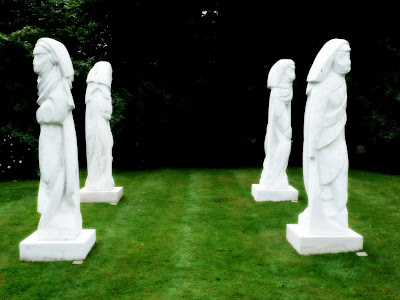The Garden Museum, on the South Bank in London, next to Lambeth Palace, has an ongoing series of evening lecture-discussions called VISTA. Co-chaired by Tim Richardson and Noel Kingsbury, the format is simple - an invited guest gives a presentation of their work after which the chairs jointly interrogate that guest on issues raised by the talk. The end of the session sees questions from the floor.
Last night it was the turn of Hal Moggridge, doyen of landscape architects, to offer his opinions on the state of landscape architecture in the UK, explored through brief exposition of a small portfolio of key works in which he has been engaged over the past four decades.
The discussion was interesting when exploring the failure of the authorities to secure and protect iconic views (especially in the capital). It is apparent that Moggridge's early architectural career in the socially-responsible 1950s - when the profession of architecture was striving to build a post-war democratic environment fit for the new, Modern, utopia - deeply influenced his outlook, and although his stance is not necessarily a 'political' one, he is clearly on the side of a public whose environment is at risk of degradation, not the side of the wealthy developer or company wanting to erect huge buildings for mere financial gain. The value of detailed and comprehensive planning to preserve the best of the built and natural environment - something which is implicit in the work of landscape and garden designers - becomes even more apparent when viewing the 'before and after' images of Moggridge's work in comparison with other, less successful interventions.
The trend towards landscape architects working on huge private estates came under scrutiny, along with the increasing trend for these tracts of land to be removed from public view - another strand in the theme of the undemocratisation of the landscape.
Discussion of Moggridge's early career with such luminaries as Geoffrey Jellicoe and Brenda Colvin raised questions of the links between garden design and landscape architecture. Tim Richardson's recent suggestion (Garden Design Journal, June 2012) that the Landscape Institute and Society of Garden Designers should combine forces, with fully accredited members being designated 'landscape designer' came up for discussion. This is an interesting possibility, and has much merit. The field of garden design is, frankly, bedevilled by the lack of an overarching body to manage the profession. Changes are under way, and the SGD has to be congratulated on its moves to increase the professionalism of garden designers. Hal Moggridge identified the crux of the matter, and I have discussed it elsewhere: until suitable garden design qualifications are accredited by the SGD or another relevant body at the source, there are only the 'post training' hoops to jump through to ensure the professionalism of garden designers. Much more sensible would be for design courses and providers to be rigorously assessed and accredited at the outset: successful completion of such a course would give an automatic, professionally recognised qualification. The tradition of gifted amateurs designing gardens for themselves and friends could be accommodated by a licentiateship or associate membership. This would have the benefit of allowing appropriately rigorous courses to advertise themselves as such, thus encouraging an improvement in training standards across the sector.
Part of the problem, from my point of view, is that so much garden design (and the vast majority of that at the amateur level) is still so driven by plants and horticulture: in a nation obsessed with the culture and cultivation of plants there is no shortage of people who are able to create pretty gardens for themselves or others - whether this makes them garden designers is a moot question, and one which I would probably answer with a 'no'. This is not to say that there aren't sufficiently talented amateurs out there, with the vision and patience to create magnificent, meaningful gardens - I'm currently reading Roy Strong's account of his garden at The Laskett, clearly a garden so rich in allusion and meaning for the makers that it could never be achieved by a designer parachuted in to draw up a ground plan. On the other hand there are (mercifully, for garden designers!) plenty of others who would love to have a beautiful garden but lack the time, knowledge, patience or creativity to make their own. Perhaps this is the real dichotomy - not 'landscape architects and garden designers', but rather 'garden designers and garden makers' - the former providing a service, the latter engaged in the very personal act of creation. Possibly the greatest skill of a designer is to become so good at the design that the end result has the same effect as a more personally created garden. Fortunately there are enough gardens in Britain to keep everyone happy and busily employed, at whatever level they are engaged with the process of making gardens!
Here's a pretty photo after all that text...













